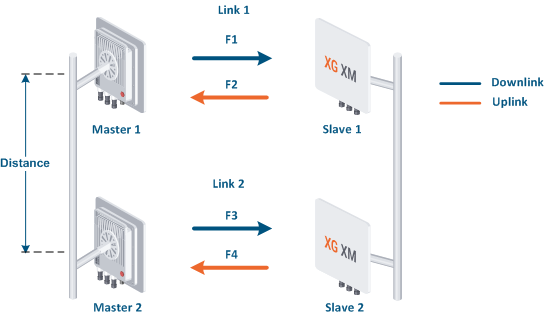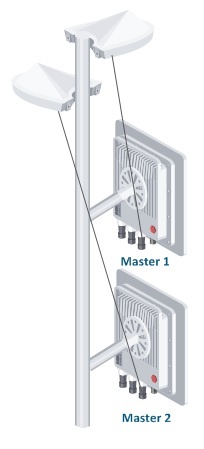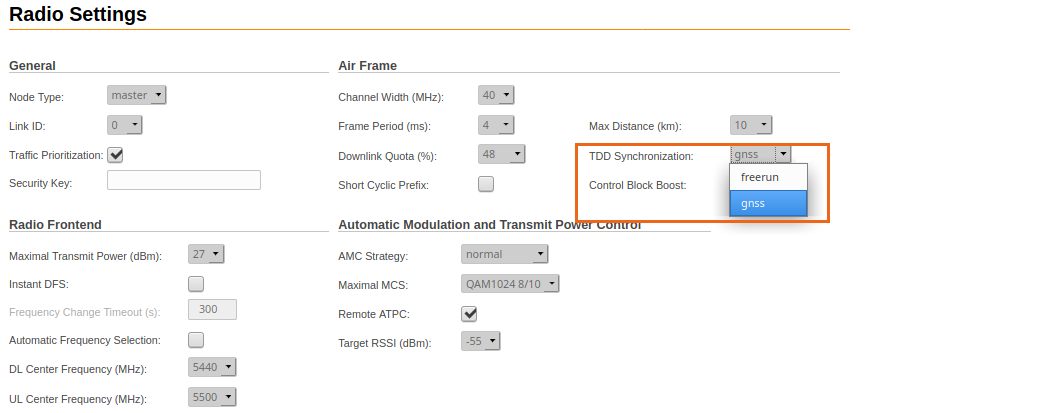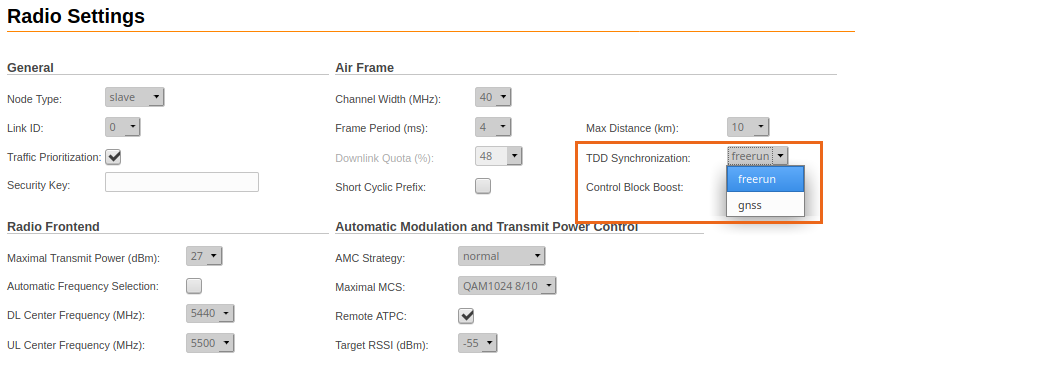...
Device Placement
| Include Page |
|---|
| Antenna Placement |
|---|
| Antenna Placement |
|---|
|
...
| Include Page |
|---|
| _Pole Requirements |
|---|
| _Pole Requirements |
|---|
|
Spectral aggregation of two wireless links
Spectral aggregation should be taken into account while planning composite backhaul links, during devices installation in close proximity to each other (on the same pole), also for redundant and aggregating links. For more information proceed to the "Link aggregation, balancing and redundancy" article. Devices located close to each other can cause mutual interference, do not ignore the spectral aggregation rules otherwise it can lead to the wireless links degradation.
| Center |
|---|
 Image Added Image Added
|
Let's look at the example with two wireless links:
- Link 1 is established between Master 1 and Slave 1 devices. Link 2 between Master 2 and Slave 2 devices.
- Links 1 and 2 are parallel to each other. The coverage areas of the Master 1 and Master 2 devices intersect, that lead to the mutual interference in case of incorrect devices diversity.
- Slave 1 and Slave 2 devices can interfere with Master 2 and Master 1. However, due to the significantly higher mutual interference between Master 1 and Master 2, interference from slave devices can be neglected.
In order to avoid the links mutual influence, it is necessary to carry out the diversity of devices in space, or to set a sufficient guard interval between the used frequency bands.
This article describes space and frequency diversity for scenarios with and without devices synchronization. The InfiLINK XG and InfiLINK XG 1000 families devices have a built-in GNSS receiver, which along with the connected external ANT-SYNC antenna allows TDD synchronization based on the signal from the satellite system. TDD (time division duplex) synchronization assumes that data are received and transmitted by devices at strictly allocated time intervals in accordance with the radio frame period and the downlink/uplink ratio settings. By default, only the slave device transmission is synchronized using the master's internal synchronization source. When the synchronization mode based on the GNSS is enabled, the devices start to receive a synchronization signal from the global navigation system and transmit data simultaneously with other InfiLINK XG devices on which this synchronization mode is activated.
Space diversity
Without synchronization
In case the GNSS based synchronization is not performed, the minimal space diversity between two devices on the same mast should be at least three meters in the horizontal or vertical plane.
| Center |
|---|
 Image Added Image Added
|
With synchronization
In case the synchronization is performed, to achieve the minimum mutual interference between the Master 1 and Master 2 devices a distance can be reduced to 1 meter.
| Center |
|---|
 Image Added Image Added
|
Frequency diversity
Without synchronization
The guard interval values for each channel width for the case the synchronization between the devices Master 1 and Master 2 is not performed are shown in the table. Increasing the guard interval beyond the recommended values does not lead to a significant improvement in RSSI.
| Center |
|---|
| Channel width, MHz | Guard interval, MHz |
|---|
| 40 | 10 | | 20 | 10 | | 10 | 5 |
|
An example of frequency diversity for a 40 MHz channel width:
| Center |
|---|
 Image Added Image Added
|
With synchronization
The GNSS synchronization of Master 1 and Master 2 devices allows to reduce guard interval size. The minimum noise level is required, as well as the interference level from a another Slave device should not exceed the RSSI level received from own Slave device. However, we do not recommend reducing the guard interval below the values shown in the table above.
| Note |
|---|
|
During InfiLINK XG 1000 family devices configuration, the minimal necessary guard interval between the center frequencies of the “Carrier 0” (first radio module) and “Carrier 1” (second radio module) should be set to: | Center |
|---|
| Channel width, MHz | Guard interval, MHz |
|---|
| 10 | 20 | | 20 | 40 | | 40 | 80 |
|
|
GNSS based synchronization settings
To perform GNSS based synchronization, each InfiLINK XG/InfiLINK XG 1000 master must be connected to an external GLONASS/GPS antenna - ANT-SYNC.
The identical radio frame period and the downlink ratio values must be set for each link to ensure the synchronization works properly. The automatic downlink ratio selection is not allowed.
| Center |
|---|
 Image Added Image Added
|
| Note |
|---|
|
The ANT-SYNC antenna is not included in the standard packing list. For more information about antenna proceed to the ANT-SYNC article. |
Configuration via WEB interface
To enable synchronization, go to the "General" - "GNSS and Location" section, check the boxes next to the "Active GNSS Antenna" and "GNSS Receiver On" options.
| Center |
|---|
 Image Added Image Added
|
Go to the "Radio" - "TDD Synchronization" section, select the "gnss" synchronization method from the drop-down list. Click the "Apply" button. GNSS synchronization must be enabled on each master device. Slave devices must remain in freerun mode and receive synchronization via master devices GNSS receivers.
| Warning |
|---|
|
In case there is no satellites available, the link will not be established in the "gnss" synchronization mode. |
Master device configuration:
| Center |
|---|
 Image Added Image Added
|
Slave device configuration:
| Center |
|---|
 Image Added Image Added
|
For more details of radio parameters configuration proceed to the "Radio" TUM section.
Configuration via CLI
The synchronization should be configured only at the master device.
Enable GNSS receiver by entering the "gps start" command. To display information about the GNSS receiver statistics use the "gps coordinates" command. The "HDOP" parameter value should be 1,5 or more, otherwise the synchronization won't work properly.
| Code Block |
|---|
|
#1> gps start
#1> gps coordinates
Satellites: 8
LAT/LONG: 56.811911/60.547041
Altitude: 275.89
HDOP: 0.92
FIX: 3D, GLONASS
Total GPS time: 17:43:19
Total nonvalid time: 00:00:01(0%)
Number of losses: 0
Now coordinates are valid last 17:43:18
Satellites histogram:
^
|
2.0 +
|
3.0 +
|
4.0 +
|
5.0 +
| <1%
6.0 +
| 1%
7.0 +
|||||||||||||||||||||||||||||||||||||||||||||||||| 99%
v
SATmin= 5 SATmax= 10 |
Enable GNSS based TDD synchronization by the "xg -tdd-sync-src gnss" command. To apply the settings, the device must be rebooted, save configuration using "config save" command, to reboot the device enter the "restart" command and confirm by "y" button.
| Code Block |
|---|
|
#1> xg -tdd-sync-src gnss
xg: there are settings that can be applied only after reboot
*tdd-sync-src
#1> config save
Current configuration saved successfully
#1> restart
Reboot... Are you sure [y/n] ?y
System restarted |







